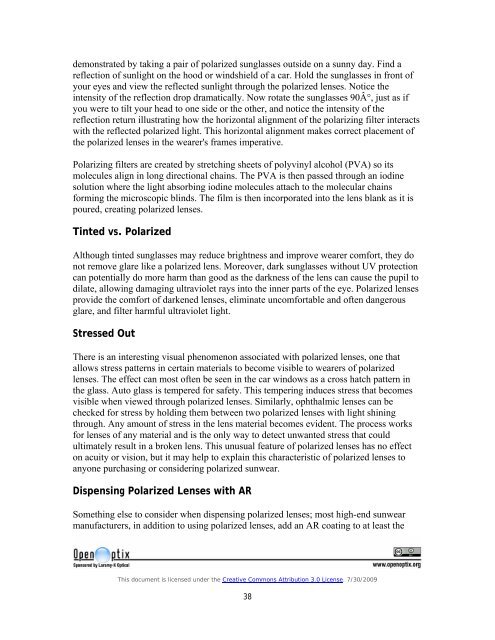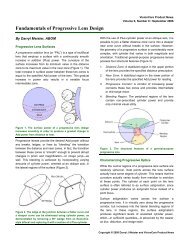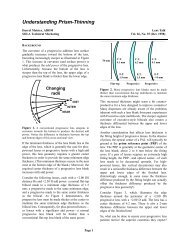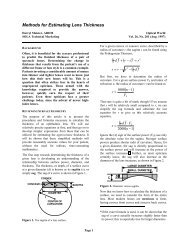OpenOptix ABO Study Guide - Laramy-K Optical
OpenOptix ABO Study Guide - Laramy-K Optical
OpenOptix ABO Study Guide - Laramy-K Optical
Create successful ePaper yourself
Turn your PDF publications into a flip-book with our unique Google optimized e-Paper software.
demonstrated by taking a pair of polarized sunglasses outside on a sunny day. Find a<br />
reflection of sunlight on the hood or windshield of a car. Hold the sunglasses in front of<br />
your eyes and view the reflected sunlight through the polarized lenses. Notice the<br />
intensity of the reflection drop dramatically. Now rotate the sunglasses 90°, just as if<br />
you were to tilt your head to one side or the other, and notice the intensity of the<br />
reflection return illustrating how the horizontal alignment of the polarizing filter interacts<br />
with the reflected polarized light. This horizontal alignment makes correct placement of<br />
the polarized lenses in the wearer's frames imperative.<br />
Polarizing filters are created by stretching sheets of polyvinyl alcohol (PVA) so its<br />
molecules align in long directional chains. The PVA is then passed through an iodine<br />
solution where the light absorbing iodine molecules attach to the molecular chains<br />
forming the microscopic blinds. The film is then incorporated into the lens blank as it is<br />
poured, creating polarized lenses.<br />
Tinted vs. Polarized<br />
Although tinted sunglasses may reduce brightness and improve wearer comfort, they do<br />
not remove glare like a polarized lens. Moreover, dark sunglasses without UV protection<br />
can potentially do more harm than good as the darkness of the lens can cause the pupil to<br />
dilate, allowing damaging ultraviolet rays into the inner parts of the eye. Polarized lenses<br />
provide the comfort of darkened lenses, eliminate uncomfortable and often dangerous<br />
glare, and filter harmful ultraviolet light.<br />
Stressed Out<br />
There is an interesting visual phenomenon associated with polarized lenses, one that<br />
allows stress patterns in certain materials to become visible to wearers of polarized<br />
lenses. The effect can most often be seen in the car windows as a cross hatch pattern in<br />
the glass. Auto glass is tempered for safety. This tempering induces stress that becomes<br />
visible when viewed through polarized lenses. Similarly, ophthalmic lenses can be<br />
checked for stress by holding them between two polarized lenses with light shining<br />
through. Any amount of stress in the lens material becomes evident. The process works<br />
for lenses of any material and is the only way to detect unwanted stress that could<br />
ultimately result in a broken lens. This unusual feature of polarized lenses has no effect<br />
on acuity or vision, but it may help to explain this characteristic of polarized lenses to<br />
anyone purchasing or considering polarized sunwear.<br />
Dispensing Polarized Lenses with AR<br />
Something else to consider when dispensing polarized lenses; most high-end sunwear<br />
manufacturers, in addition to using polarized lenses, add an AR coating to at least the<br />
This document is licensed under the Creative Commons Attribution 3.0 License. 7/30/2009<br />
38









